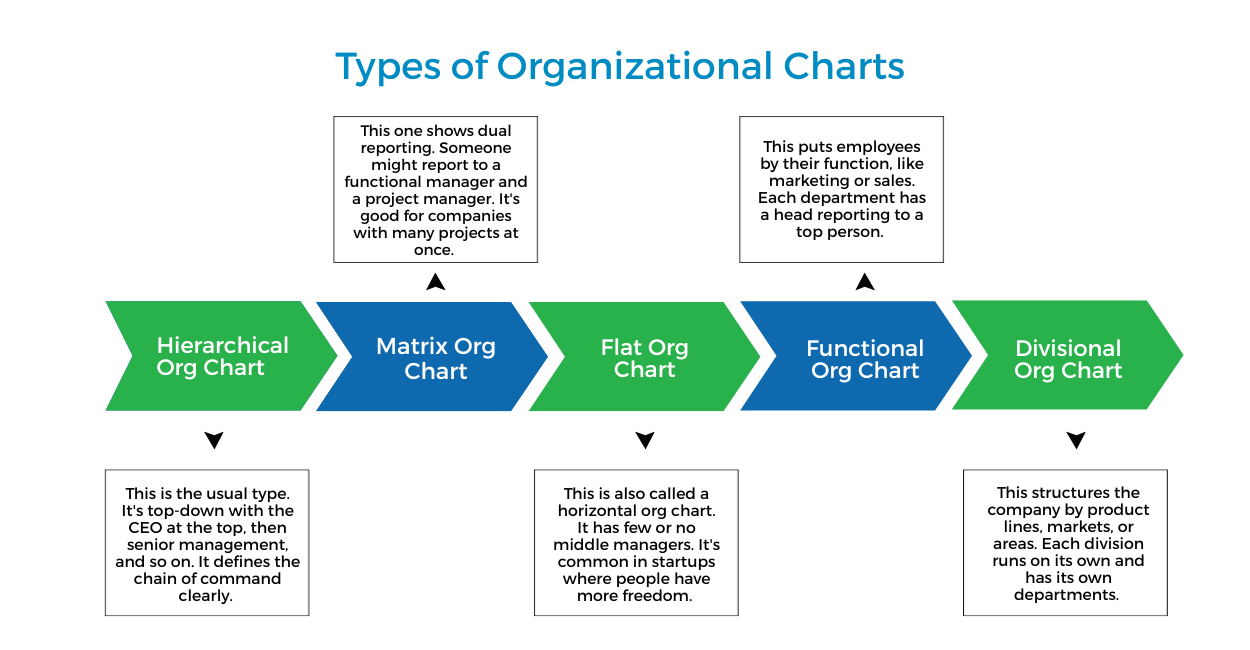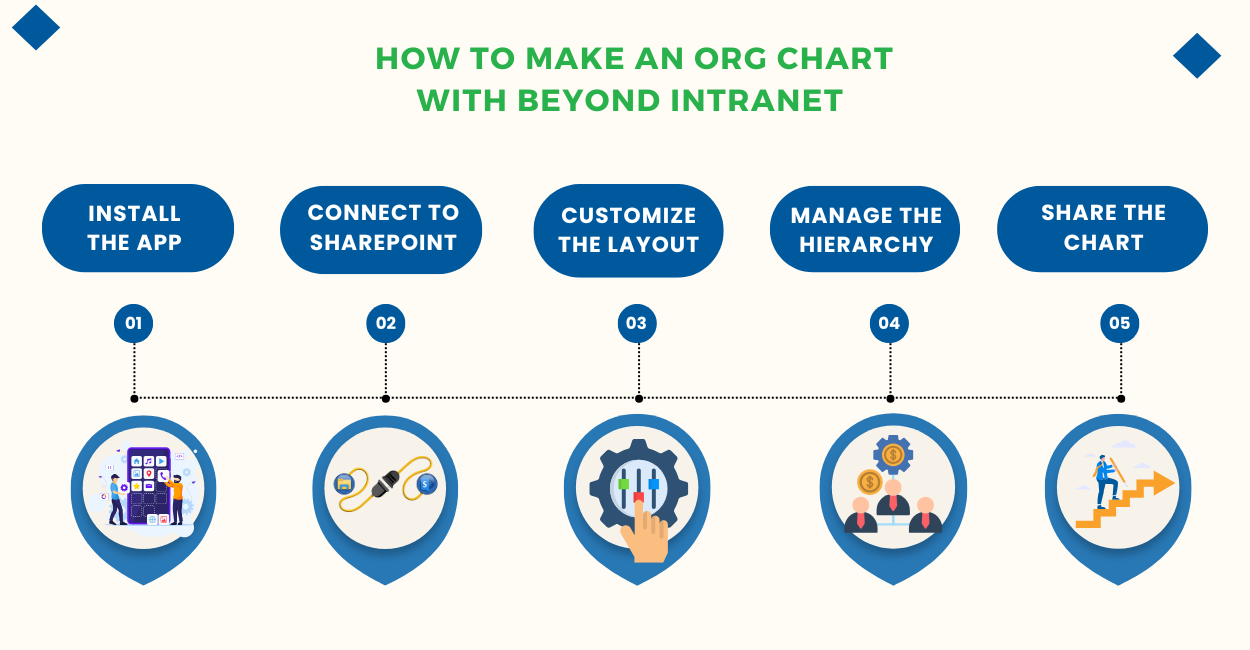Organizational Chart: What It Is, Types, and How It Works
Are you ever unsure who reports to whom in your company? It’s a common problem for HR, and it can affect how well you communicate and how efficiently things get done. Let’s see how organizational charts can be a solution.
Understanding Organizational Charts
What is an organizational chart?
An organizational chart, or org chart, is a visual way to show your company’s structure. It’s like a map of your people, what they do, and how they connect. Boxes and lines show who reports to whom and connect different departments. Think of it as a family tree, but for your company!
And what is an org chart?
Same thing. You might hear it called an “organization structure chart” or even an “organogram.” It’s all the same: a diagram that shows the relationships in your company. It gives you a clear picture of the hierarchy and how things work.
Why are org charts important?
So, why bother with an org chart? Here’s what they help with:
- Clarity for everyone: New hires quickly see their place. Existing employees see how their roles fit.
- Improved communication: Knowing who reports to whom helps get information to the right people.
- Better restructuring: When you need to reorganize, an org chart helps you see how to merge or move resources.
- Resource planning: Spot gaps in teams and see who might be overloaded.
Key parts of an org chart
To make a useful org chart, include these things:
- Positions: Job titles and roles.
- Relationships: Lines showing who reports to whom. These lines define the chain of command.
- Departments: Groupings of roles by function, location, or product.
Exploring Types of Organizational Charts

Okay, so you know what an org chart is, but what kinds are there?
- Hierarchical Org Chart: This is the usual type. It’s top-down with the CEO at the top, then senior management, and so on. It defines the chain of command clearly.
- Matrix Org Chart: This one shows dual reporting. Someone might report to a functional manager and a project manager. It’s good for companies with many projects at once.
- Flat Org Chart: This is also called a horizontal org chart. It has few or no middle managers. It’s common in startups where people have more freedom.
- Functional Org Chart: This puts employees by their function, like marketing or sales. Each department has a head reporting to a top person.
- Divisional Org Chart: This structures the company by product lines, markets, or areas. Each division runs on its own and has its own departments.
Examples of an organizational chart
To give you a better idea, here are some examples:
- Small startup: Might use a flat org chart, with the founder and everyone reporting to them.
- Big company: Probably uses a hierarchical org chart, with many layers.
- Project-based company: Could use a matrix org chart to show how people from different departments work on projects.
Creating Your Own Org Chart
So, you’re thinking about creating an org chart for your organization? Great! Here’s how to get started:
How to create an organisation chart
It might seem hard, but here’s how to do it:
1. Get your info: Collect details on roles, departments, and reporting.
2. Pick a format: Decide what type of org chart fits your company.
3. Use a tool: Use software or templates to create the chart.
4. Add data: Put all the info in the format you picked.
5. Check it: Make sure it’s correct and change it as needed.
Best practices and tips
Here are some tips to keep in mind when building your org chart:
- Keep it simple: Don’t add too much detail.
- Use clear titles: Make job titles easy to understand.
- Update it regularly: Keep the chart current.
- Include photos: Adding photos can help people connect names and faces, especially in larger organizations.
- Color-code: Use different colors for different departments or teams.
Common mistakes
- Old info: Make sure the chart is up to date.
- Too complex: Keep it easy to read.
- Ignoring feedback: Ask people what they think to make it better.
Keeping your org chart current
You need to keep your org chart current. Update it when roles or departments change. Check it regularly, like every few months.
Tell everyone about updates so they know the latest structure. You can do this with emails or on your company site.
Choosing the Right Tools
Okay, you’re ready to make an org chart. What tools can you use?
5 Tools and software for creating org charts
You have several options for creating your org chart. Here are a few:
1. Microsoft Visio: A popular option with many templates and good integration with other Microsoft products.
2. Lucidchart: Offers real-time collaboration and an easy-to-use interface.
3. SmartDraw: Provides automated formatting and a wide range of templates.
4. SharePoint: You can create basic org charts within SharePoint using lists or the Organization Browser web part.
What about SharePoint?
Many organizations already use SharePoint. Did you know you can leverage it for your org chart? A SharePoint org chart can provide easy access to employee information and improve communication, as discussed in this article. Learn More
What if you already use SharePoint?
If you’re already using SharePoint, you might be wondering how to make the most of it for your org chart.
Benefits of using a SharePoint org chart
- Easy info: It gives you employee information for better communication.
- Clear roles: It makes job titles and roles clear, improving efficiency.
- Simple restructuring: It’s a way to see how to merge teams for better management.
- Good resource planning: You can find resource gaps and employee skills fast.
- Remote team view: If your teams are in different places, a SharePoint org chart helps you see how they’re set up.
How to make an org chart with Beyond Intranet

If you’re looking for a way to simplify the process and keep your org chart automatically updated, you might consider a dedicated solution.
Our HR Org Chart 365 integrates directly with SharePoint, automatically pulling data from user profiles to keep your chart up-to-date. Here’s how it simplifies things:
1. Install the app: Add HR Org Chart 365 to your SharePoint environment.
2. Connect to SharePoint: The app automatically connects to your SharePoint user profiles.
3. Customize the layout: Choose from different views (horizontal, compact) and customize the look to match your branding.
4. Manage the hierarchy: Assign the top person in your organization and exclude any unwanted or deactivated employees.
5. Share the chart: Make the org chart available to everyone on your intranet.
Layout and Syncing
- Easy syncing of employee information from SharePoint user profile
- Self-explanatory flowchart to depict company hierarchy
- Display employee information in an attractive tile pattern
- Show profile picture, name, department, and designation
- Export to Excel
Configure and Manage Hierarchy Content Yourself
- Assign alternate departments or managers to the same employee easily
- Filter employees easily based on departments
- Show employees who have no reporting managers separately
- Exclude employees using Excluded Users Name
Manage Your Hierarchy View
- Switch between vertical or horizontal view easily
- User-based access on the Configuration section
- Different tile colors to show employees listed in multiple departments
- Exclude any department easily
- Department Mapping enables you to start a hierarchy from any department
Beyond Intranet’s SharePoint Org Chart is available in two attractive formats
1. Horizontal view
2. Compact View
Easy Installation Process
To get more details and download a free trial, explore our SharePoint Organization Chart.
To get a free demo of the application, you can book a session with one of our technical SharePoint experts.
Beyond Intranet’s Org Chart Application
It automatically picks up the data that is available on the SharePoint user profile and maps each field with the field on the cards. Employees can keep their profiles updated and so it is updated on the chart as well. It saves a lot of effort and time for HR managers.
The layout of the chart display is easy to handle. There is a lot of flexibility to personalize the look and feel of the application and brand it to your organization’s theme and logo. And this is not all. There are several other benefits of using modern SharePoint org charts.
One can use the SharePoint org chart as a standalone add-in, as well as a web part on a Corporate Intranet page. We have a complete suite of products that are really meant for human resource managers and administrators and automate their tedious manual processes.
Understanding Organizational Structure
Relationship between org charts and organizational structure
Org charts visually represent the organizational structure, showcasing how different roles and departments interact. They highlight the hierarchy and can reveal gaps or overlaps in responsibilities, making it easier to identify areas needing adjustment.
How org charts reflect company hierarchy?
Org charts display the hierarchy, showing who reports to whom and how decisions flow through the company. It helps everyone understand their role, accountability, and clarity across the organization.
Impact on communication and workflow
Clear organizational structures improve communication and workflow by defining reporting lines and responsibilities. They help prevent misunderstandings and tasks are directed to the appropriate individuals, enhancing overall efficiency and productivity within the company.
The Evolution of Org Charts
Traditional vs. contemporary approaches
Traditional org charts focused on strict hierarchies, often presenting a top-down structure with clearly defined lines of authority. Contemporary approaches emphasize flexibility, with charts evolving to include matrix structures and support for remote teams.
Adapting org charts for remote and hybrid work environments
Modern org charts need to reflect remote and hybrid work environments, ensuring clarity in reporting lines and communication channels despite physical distances. This involves incorporating digital tools and platforms that facilitate communication and collaboration among geographically dispersed teams.
Conclusion
Organizational charts are vital for visualizing your company’s structure, clarifying roles, and improving communication. By understanding the different types of org charts and how to create and maintain them, you can enhance your operational efficiency and employee understanding.
Ready to experience the benefits and simplify your org chart management? Get a Free Demo of our HR Org Chart 365 and see how it can transform your organization.






